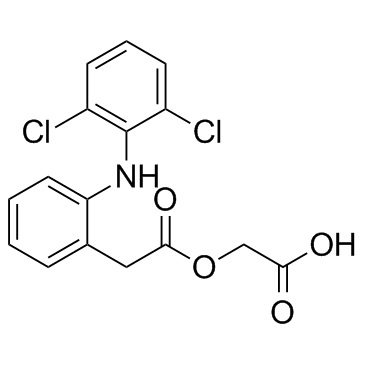Drug-induced Sweet's syndrome by aceclofenac.
Rodrigo Carvalho, Cândida Fernandes, Ana Afonso, Jorge Cardoso
文献索引:Cutan. Ocul. Toxicol. 30(4) , 315-6, (2011)
全文:HTML全文
摘要
Sweet's syndrome (SS) or acute febrile neutrophilic dermatosis is a reactive process that presents in different clinical settings and ranges from classical (idiopathic), malignancy associated or drug induced. The authors describe a 51-year-old Caucasian woman referred to our department with a 3-day history of pseudovesicular reddish papules on her neck, upper trunk and limbs. Two days prior to the eruption, aceclofenac 100 mg every 8 h was initiated for lower back pain. She also complained of high fever (39°C), arthralgias and general malaise. Laboratory evaluation showed an elevation of erythrocyte sedimentation rate and C reactive protein. A biopsy specimen of skin lesions showed throughout the upper reticular dermis a dense infiltrate of mature neutrophils. Aceclofenac was discontinued and oral prednisolone (0.5 mg/kg) was started. Fever resolved within 48 h, whereas cutaneous lesions cleared within the first week. No relapse was noted after a 6-month follow-up period. Drug-induced SS by aceclofenac diagnosis was sustained by the presence of all the five diagnostic criteria for drug-induced SS presented by Walker and Cohen in 1996. Several hundred cases of SS have been reported in the literature. However, drug-induced SS represent overall less than 5% of all cases, mostly as isolated clinical cases. Reports of nonsteroidal anti-inflammatory drug-induced SS include diclofenac, celecoxib and rofecoxib. Our patient represents the first case of aceclofenac-induced SS and illustrates the need to enquire about recent drugs in a patient with suspicion of SS.
相关化合物
| 结构式 | 名称/CAS号 | 分子式 | 全部文献 |
|---|---|---|---|
 |
醋氯芬酸
CAS:89796-99-6 |
C16H13Cl2NO4 |
|
Development and implication of methodology for aceclofenac i...
2013-01-01 [Pak. J. Pharm. Sci. 26(1) , 169-73, (2013)] |
|
Electrospun zein/eudragit nanofibers based dual drug deliver...
2012-11-15 [Int. J. Pharm. 438(1-2) , 117-22, (2012)] |
|
Absolute bioavailability and metabolism of aceclofenac in ra...
2015-01-01 [Arch. Pharm. Res. 38(1) , 68-72, (2015)] |
|
Aceclofenac-loaded chitosan-tamarind seed polysaccharide int...
2013-05-01 [Colloids Surf. B Biointerfaces 105 , 303-9, (2013)] |
|
Nanomiemgel--a novel drug delivery system for topical applic...
2014-01-01 [PLoS ONE 9(12) , e115952, (2014)] |